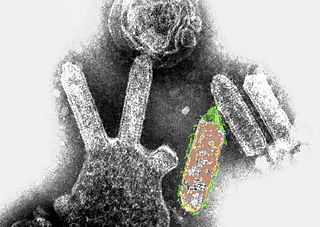
The Rhabdoviridae are a family of viruses in the order Mononegavirales. Vertebrates, invertebrates, and plants serve as natural hosts. Currently, 18 genera are recognised. Diseases associated with viruses of this family include rabies encephalitis caused by rabies virus, and vesicular diseases and encephalitis flu-like symptoms in humans caused by vesiculoviruses. The name is derived from the Greek rhabdos, meaning rod, referring to the shape of the viral particles.

Lyssavirus is a genus of RNA viruses in the family Rhabdoviridae, order Mononegavirales. Mammals, including humans, can serve as natural hosts. The genus Lyssavirus includes the rabies virus traditionally associated with that disease.

Rabies lyssavirus, formerly Rabies virus, is a neurotropic virus that causes rabies in humans and animals. Rabies transmission can occur through the saliva of animals and less commonly through contact with human saliva. Rabies lyssavirus, like many rhabdoviruses, has an extremely wide host range. In the wild it has been found infecting many mammalian species, while in the laboratory it has been found that birds can be infected, as well as cell cultures from mammals, birds, reptiles and insects.

Australian bat lyssavirus (ABLV), initially named Pteropid lyssavirus (PLV), is a zoonotic virus closely related to the rabies virus. It was first identified in a 5-month-old juvenile black flying fox collected near Ballina in northern New South Wales, Australia, in January 1995 during a national surveillance program for the recently identified Hendra virus. ABLV is the seventh member of the genus Lyssavirus and the only Lyssavirus member present in Australia.
Mokola virus (MOKV) is a RNA virus related to rabies virus that has been sporadically isolated from mammals across sub-Saharan Africa. The majority of isolates have come from domestic cats exhibiting symptoms characteristically associated to rabies virus infection.
Lagos bat lyssavirus, formerly Lagos bat virus (LBV) is a Lyssavirus of southern and central Africa that causes a rabies-like illness in mammals. It was first isolated from a fruit bat from Lagos Island, Nigeria in 1956. Brain samples from the bat showed poor cross-reactivity to rabies antibodies but the virus was found to be closely related to the rabies virus. This was the first discovery of a rabies-related virus. Until this time, rabies was thought to have a single causal agent.
Duvenhage lyssavirus (DUVV) is a member of the genus Lyssavirus, which also contains the rabies virus. The virus was discovered in 1970, when a South African farmer died of a rabies-like encephalitic illness, after being bitten by a bat. In 2006, Duvenhage virus killed a second person, when a man was scratched by a bat in North West Province, South Africa, 80 km from the 1970 infection. He developed a rabies-like illness 27 days after the bat encounter, and died 14 days after the onset of illness. A 34-year-old woman who died in Amsterdam on December 8, 2007 was the third recorded fatality. She had been scratched on the nose by a small bat while travelling through Kenya in October 2007, and was admitted to hospital four weeks later with rabies-like symptoms.

Rabies is a viral disease that causes inflammation of the brain in humans and other mammals. Early symptoms can include fever and tingling at the site of exposure. These symptoms are followed by one or more of the following symptoms: violent movements, uncontrolled excitement, fear of water, an inability to move parts of the body, confusion, and loss of consciousness. Once symptoms appear, the result is nearly always death. The time period between contracting the disease and the start of symptoms is usually one to three months, but can vary from less than one week to more than one year. The time depends on the distance the virus must travel along peripheral nerves to reach the central nervous system.
The Central Nervous System controls most of the functions of the body and mind. It comprises the brain, spinal cord and the nerve fibers that branch off to all parts of the body. The Central Nervous System viral diseases are caused by viruses that attack the CNS. Existing and emerging viral CNS infections are major sources of human morbidity and mortality. Virus infections usually begin in the peripheral tissues, and can invade the mammalian system by spreading into the peripheral nervous system and more rarely the CNS. CNS is protected by effective immune responses and multi-layer barriers, but some viruses enter with high-efficiency through the bloodstream and some by directly infecting the nerves that innervate the tissues. Most viruses that enter can be opportunistic and accidental pathogens, but some like herpes viruses and rabies virus have evolved in time to enter the nervous system efficiently, by exploiting the neuronal cell biology. While acute viral diseases come on quickly, chronic viral conditions have long incubation periods inside the body. Their symptoms develop slowly and follow a progressive, fatal course.
Almost all human deaths caused by rabies occur in Asia and Africa. There are an estimated 59,000 human deaths annually from rabies worldwide.
Neurovirology is an interdisciplinary field which represents a melding of clinical neuroscience, virology, immunology, and molecular biology. The main focus of the field is to study viruses capable of infecting the nervous system. In addition to this, the field studies the use of viruses to trace neuroanatomical pathways, for gene therapy, and to eliminate detrimental populations of neural cells.
Rabies has been the main plot device or a significant theme in many fictional works. Due to the long history of the virus as well as its neurotropic nature, rabies has been a potent symbol of madness, irrationalism, or an unstoppable plague in numerous fictional works, in many genres. Many notable examples are listed below.

Arctic rabies virus is a strain of Rabies lyssavirus that circulates throughout the arctic regions of Alaska, Canada, Greenland, Finland, Sweden, Norway, and Russia. The Arctic fox is the main host.

Cryptic rabies refers to infection from unrecognized exposure to rabies virus. It is often phylogenetically traced to bats. It is most often seen in the southern United States. Silver-haired bats and tricolored bats are the two most common bat species associated with this form of infection, though both species are known to have less contact with humans than other bat species such as the big brown bat. That species is common throughout the United States and often roosts in buildings and homes where human contact is more likely.

A bat-borne virus is any virus whose primary reservoir is any species of bat. The viruses include coronaviruses such as severe acute respiratory syndrome coronavirus (SARS-CoV) and severe acute respiratory syndrome coronavirus 2 (SARS-CoV-2); hantaviruses; lyssaviruses such as rabies virus and Australian bat lyssavirus; henipaviruses such as nipah virus and Hendra virus; Lassa virus; Ebola virus; and Marburg virus. Several bat-borne viruses are considered important emerging viruses.
European bat 1 lyssavirus(EBLV-1) is one of three rabies virus-like agents of the genus Lyssavirus found in serotine bats in Spain. Strains of EBLV-1 have been identified as EBLV-1a and EBLV-1b. EBLV-1a was isolated from bats found in the Netherlands and Russia, while EBLV-1b was found in bats in France, the Netherlands and Iberia. E. isabellinus bats are the EBLV-1b reservoir in the Iberian Peninsula. Between 1977 and 2010, 959 bat rabies cases of EBLV-1 were reported to the World Health Organization (WHO) Rabies Bulletin.
European bat 2 lyssavirus(EBLV-2) is one of three rabies virus-like agents of the genus Lyssavirus found in Daubenton's bats in Great Britain. Human fatalities have occurred: the naturalist David McRae who was bitten by a Daubenton's bat in Scotland, became infected with EBLV-2a and died in November 2002. It must now be assumed that the virus is present in bats in the UK. Testing of dead bats by MAFF/DEFRA over the last decade indicates that the overall incidence of infection is likely to be very low, although limited testing of live Daubenton's bats for antibodies suggests that exposure to EBLV-2 may be more widespread. Nevertheless, infected bat bites have caused human deaths so appropriate precautions against infection must be taken. The Department of Health’s recommendation is that people regularly handling bats should be vaccinated against rabies. Included in this category are all active bat workers and wardens, and those regularly taking in sick and injured bats. The Statutory Nature Conservation Organisations and the Bat Conservation Trust urge all those involved in bat work to ensure that they are fully vaccinated and that they receive regular boosters. Bats should not be handled by anyone who has not received these vaccinations. Even when fully vaccinated, people should avoid being bitten by wearing appropriate bite-proof gloves when handling bats. Any bat bite should be thoroughly cleansed with soap and water and advice should be sought from your doctor about the need for post-exposure treatment. Further information is available from the SNCOs, the Bat Conservation Trust or the Health Protection Agency (HPA) /Scottish Centre for Infection and Environmental Health (SCIEH).
Bokeloh bat lyssavirus (BBLV) is negative-sense, single-stranded RNA virus of the genus Lyssavirus first isolated from a Natterer's bat found in Bokeloh, Lower Saxony, Germany in 2010.
A notifiable disease is one which the law requires to be reported to government authorities.
West Caucasian bat lyssavirus (WCBL) is a member of genus Lyssavirus, family Rhabdoviridae and order Mononegavirales. This virus was first isolated from Miniopterus schreibersii, in the western Caucasus Mountains of southeastern Europe in 2002. WCBL is the most divergent form of Lyssavirus, and is found in Miniopterus bats (insectivorous), Rousettus aegyptiacus, and Eidolon helvum. The latter two are both fruit bats. The virus is fragile as it can be inactivated by UV light and chemicals, such as ether, chloroform, and bleach. WCBL has not been known to infect humans thus far.






